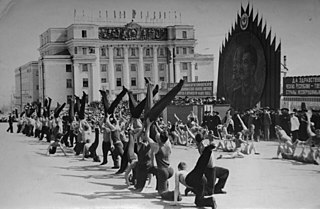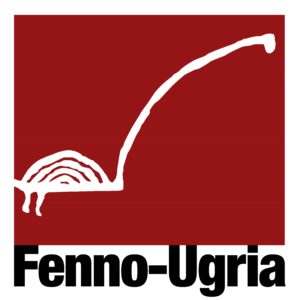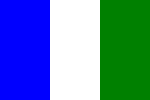
Finno-Ugric is a traditional grouping of all languages in the Uralic language family except the Samoyedic languages. Its formerly commonly accepted status as a subfamily of Uralic is based on criteria formulated in the 19th century and is criticized by some contemporary linguists such as Tapani Salminen and Ante Aikio. The three most spoken Uralic languages, Hungarian, Finnish, and Estonian, are all included in Finno-Ugric.

The penultimate USSR-era flag was adopted by the Russian Soviet Federative Socialist Republic (RSFSR) in 1954 and used until 1991. The flag of the Russian SFSR was a defacement of the flag of the USSR. The constitution stipulated:
The state flag of the Russian Soviet Federative Socialist Republic (SFSR) presents itself as a red, rectangular sheet with a light-blue stripe at the pole extending all the width [read height] which constitutes one eighth length of the flag.

Mari El, officially the Mari El Republic, is a republic of Russia. It is in the European region of the country, along the northern bank of the Volga River, and administratively part of the Volga Federal District. The republic has a population of 696,459. Yoshkar-Ola is the capital and largest city.

The Mari are a Finno-Ugric people in Eastern Europe, who have traditionally lived along the Volga and Kama rivers in Russia. Almost half of Maris today live in the Mari El republic, with significant populations in the Bashkortostan and Tatarstan republics. In the past, the Mari have also been known as the Cheremisa or the Cheremis people in Russian and the Çirmeş in Tatar.

Mordvins is an official term used in the Russian Federation to refer both to Erzyas and Mokshas since 1928.

The flag of Tatarstan; ; a republic of Russia, was introduced in 1991.
The flags of the Soviet Socialist Republics were all defaced versions of the flag of the Soviet Union, which featured a golden hammer and sickle and a gold-bordered red star on a red field.

Leonid Igorevich Markelov is a Russian politician and lawyer, who is the former head of the Mari El republic in Russia. He took office on January 14, 2001, and resigned from office on April 6, 2017. Markelov was later arrested under suspicion of accepting bribes.

The Flag of Udmurtia is one of the official state symbols of Udmurtia. The proportion of width and length of the flag is 1:2. It is a rectangular three-color cloth consisting of vertical equal stripes of black, white and red with an eight-pointed red cross. The black colour in the flag is a symbol of the earth and stability, red means the sun and life and white means a space and moral purity. The designer of the flag of the Udmurt Republic was Yuri Lobanov. The appropriate law N26-РЗ "On the National Flag of the Udmurt Republic" appeared on April 30, 2002.

The Mari Autonomous Soviet Socialist Republic was an autonomous republic of the Russian SFSR, succeeding the Mari Autonomous Oblast. When the Soviet Union disintegrated, the Mari ASSR became the Mari El Republic, a federal subject of the Russian Federation.

The flag of the Chuvash Republic, in the Russian Federation, is one of the official symbols of the Chuvash Republic, alongside the coat of arms and the State Anthem of the Chuvash Republic. The flag is a 5:8 yellow flag with a stylized red tree of life charged on the flag. The flag has been used officially as the flag of the Chuvash Republic since 14 October 1992.

The flag of the Republic of Sakha (Yakutia) (Yakut: Саха Өрөспүүбүлүкэтин былааҕа Saqa Öröspüübülüketin Bılaağa; Russian: Флаг Республики Саха (Якутия)), in the Russian Federation, is one of the official symbols of the Sakha Republic, alongside the coat of arms and the national anthem of the Sakha Republic. The flag has four horizontal stripes. From top to bottom, the stripes are light blue (3/4 of the flag's width), white (1/16), red (1/16), and green (1/8). The flag has been used officially as the flag of the Sakha Republic since 14 October 1992. The light blue stripe is charged with a white disc in the center. The diameter of the disc is 2/5 of the flag's width.

The Flag of the Komi Republic in Russia is one of the official symbols of the federal subject, alongside the coat of arms and the State Anthem of the Komi Republic. The flag is a horizontal tricolour with 2:3 proportion. The flag was composed of three bars of, from top to bottom, medium blue, green, and white.

The flag of the Republic of Bashkortostan, in the Russian Federation, is one of the official symbols of the Republic of Bashkortostan, alongside the coat of arms and the national anthem of Bashkortostan. The flag has three horizontal stripes. From top to bottom, the stripes are teal blue, white, and green. The flag has been used officially as the flag of the Republic of Bashkortostan since 25 February 1992. The white stripe of the flag is charged with a Kurai flower in the center.

The Russian Soviet Federative Socialist Republic, previously known as the Russian Soviet Republic and the Russian Socialist Federative Soviet Republic, and unofficially as Soviet Russia, was an independent federal socialist state from 1917 to 1922, and afterwards the largest and most populous constituent republic of the Soviet Union (USSR) from 1922 to 1991, until becoming a sovereign part of the Soviet Union with priority of Russian laws over Union-level legislation in 1990 and 1991, the last two years of the existence of the USSR. The Russian SFSR was composed of sixteen smaller constituent units of autonomous republics, five autonomous oblasts, ten autonomous okrugs, six krais and forty oblasts. Russians formed the largest ethnic group. The capital of the Russian SFSR and the USSR as a whole was Moscow and the other major urban centers included Leningrad, Stalingrad, Novosibirsk, Sverdlovsk, Gorky and Kuybyshev. It was the first socialist state in the world.

The flag the Mari Autonomous Soviet Socialist Republic was adopted in 1954 by the government of the Mari Autonomous Soviet Socialist Republic. The flag is identical to the flag of the Russian Soviet Federative Socialist Republic.

The coat of arms of the Sakha Republic, in the Russian Federation, is an official symbol of the Sakha Republic, alongside the flag and the national anthem of the Sakha Republic. The coat of arms consists of a circle, in the center of which is a red silhouette of a rider on horseback holding a banner, based on the prehistoric petroglyphs of the "Shishkin pisanitsa", against a white sun background. The central image is framed with a traditional Sakha ornament in the form of seven rhombic crystal-like figures and the inscriptions "Республика Саха (Якутия) • Саха Өрөспүүбүлүкэтэ". This coat of arms has been used officially since 26 December 1992.
Lydia Petrovna Vasikova was a Soviet and Russian Finno-Ugric linguist, the first among Mari women, who became a Doctor of Science (1985), a professor (1986), an Honored Scientist of the Russian Federation (1995), and a holder of the Order of the Cross of the Land of Mary (Estonia).

World Congress of Finno-Ugric Peoples is the representative forum of Finno-Ugric and Samoyedic peoples. The forum is not related to any government or political party. The goals of the forum is to "develop and protect national identity, cultures and languages of Finno-Ugric peoples, to promote cooperation between Finno-Ugric peoples, to discuss topical issues and to identify solutions, and to realise the right of Finno-Ugric peoples to self-determination in accordance with international norms and principles".

Mari Ushem is a Russian non-governmental organization, whose activity is dedicated to preservation of the Mari culture.




























